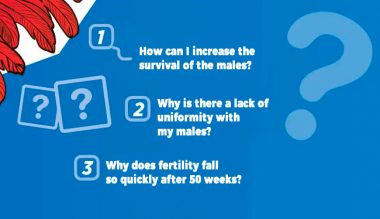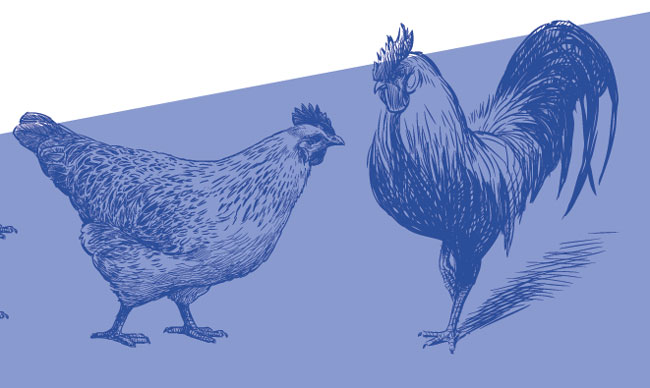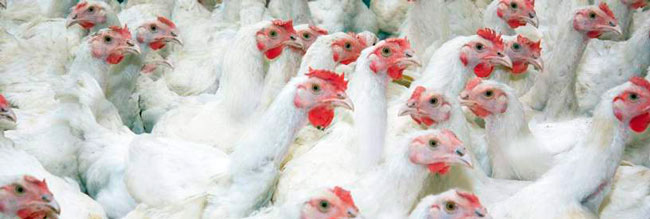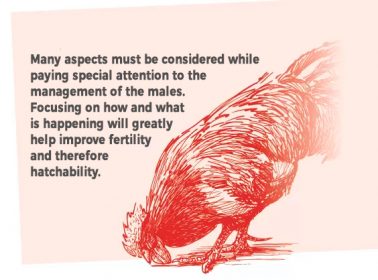HATCHERY PHASE
Content available at:
Español (Spanish)
Despite the fact that both males and females contribute to the appearances of fertility problems, the impact of the male on the fertility of the flock is approximately 10 times greater than that of the females, due to the 1:10 ratio of males and females.
Ultimately, fertility from the male’s point of view depends on:
The continuous selection in favour of typical broiler characters does not seem to affect negatively the sperm quality. However, current males seem to gain weight more easily, potentially leading to lower efficiency and interest in copulation. Males are more susceptible to stress than females due to the severity of their feeding restrictions, but traditionally the industry has paid more attention to females, particularly in hatcheries, rearing and production.
Males have often been “left to fend for themselves” when they should be receiving more attention, due to their special needs during such a stressful period as rearing.
There are several elements to focus on to improve the management of males during the Hatchery, Rearing and Production phases, and several issues should be taken into consideration: 
HATCHERY PHASE
At the beginning of the Hatchery Phase, the chick has a developing immune system and poor temperature regulation capacity. Chick Processing and preparation in the hatchery can also cause stress, leading to a loss of uniformity if the birds are not handled properly. Damages caused in the first two weeks of life may not manifest until later in the chick’s life, so it is important to create a “Comfort Zone” for chicks in the Rearing Phase, where they are provided with an environment with an adequate temperature and freely available feed and water.
The layout of the equipment is critical to creating the perfect “Comfort Zone” for the chicks so that they do not have to choose between heat, feed or water, but must be able to access all these elements at the same time.
KEY POINTS WHEN CREATING THE COMFORT ZONE

It is important to provide enough plates with enough feed in each one. If all the dishes are always full of chicks, this implies that the number of dishes is insufficient. An insufficient amount of feeder space and / or quantity of feed will have a negative impact on feed consumption, as well as on the weight and uniformity of the birds. It is recommended to supply at least 1.5 kg of balanced starter feed to males to achieve adequate development and weight gain. REARING PHASE
During the Breeding Phase, the required trough space for a feed chain is 20 cm (7.5”) and a plate for every 8 males from 5 weeks until thinning. It is essential that all males eat simultaneously to ensure the uniformity of the flock. The housing density should be at least 0.2 m2/male (2.5 ft2/male), with 1 teat/8 cockerels and 1 drinker/60 cockerels. If the recommended space cannot be provided, the males can still be reared and managed to achieve good fertility and hatching rate, although this is more difficult.
There are many alternative methods that, if implemented correctly, can lead to good uniformity. To avoid any loss in the flock, it is important to focus on management ideas that contribute to good uniformity, especially when there is a limitation of floor space and feeders.
During this phase, males should never lose weight from one week to the next, as stagnation or loss during the critical periods of this phase can result in a decrease in hatchability potential in young breeders.
These critical periods of rearing include the first few weeks, 8-12 weeks, and the first 3 weeks after lighting.
Males are more tolerant from 24-30 weeks than previously thought. It is important to control the weight and muscular development of the males at 30 weeks of life. If the flock deviates from the target weight or muscle development, it is important to take precautions to get them back on the weight curve. Checking the response to vaccination is also essential in a good male program. This practice is often overlooked, leading to program failure. Taking the time to check each flock is crucial, as you never know what problems might come up. Too many shots of vaccines will greatly affect the uniformity of the flock.
PRODUCTION PHASE
The third and final phase of Breeder Management is the Production Phase. During this phase there are many points to consider regarding housing. It is important to remember that the day before transport should be a day for feeding, and a whole house should always be moved each day. Water should be freely available upon arrival and the change of equipment should be evaluated when moving from the rearing to the production house. A good practice for housing breeders is to have a male to female ratio of 7.5-10.0%.
<p
However, these male-female ratios should be adjusted based on the selected breeding male, as many new males may exhibit higher levels of aggression than their predecessors. 

Controlling weight gain and muscle development of the males is very important during the Production Phase, with body weight being a useful tool to evaluate the progress of the flock. Likewise, the uniformity and condition of the flock, based on the muscle and breast development, are useful tools to know the process. Males should always be handled on a regular basis and it is important to note that the flocks may have similar average weights, but the body composition may vary. The key to controlling males is feed restriction. By using a female only grill (FOG) and placing male feeders at too high a height for the females, feed intake can be controlled for both sexes.

Some common mistakes that are made when controlling males are:
During the Production Phase, spiking programs can be implemented. There are three different types of spiking programs that can be incorporated into a breeder program:
The new male spiking method uses young males, 25-27 weeks old, as primary spike males.
The intra-spiking method uses males that are being switched from one house to another. The males used in this method are the same age as the initial males with which they are introduced.
Finally, the back spiking method uses males introduced into a chicken farm as new spikes and which are subsequently removed before the sale of the original flock, to take them to another flock.
Spiking programs can stimulate older males to increase their mating activity, lasting almost six weeks. The reactivation of fertility in the short term will only occur if the males are still physically capable of copulating. As young males gain experience, which can take 4-6 weeks, their copulating efficiency also increases, eventually outperforming resident males.
Optimal mating efficiency for spiking males occurs at around 9 weeks post-spiking. The combined effect of the older males and the spike males will produce a desired result in the fertility of the flock. Spiking, while beneficial in many ways, can also have negative effects. Biosecurity must be considered here, as there could be a risk of cholera, mites and mycoplasmosis or other diseases. Biosecurity can also be affected by different vaccination programs applied in different flocks.
Additional costs are also affected by spiking as well as feed spacing. There is also a possibility that males raised in spike houses are not always ready when the flock is ready for spiking. 
Subscribe now to the poultry technical magazine
AUTHORS

Layer Longevity Starts at Rearing
H&N Technical Team
The Strategy for a Proper Infectious Bronchitis Control
Ceva Technical Team
Elevate Hatchery Performance with Petersime’s New Data-Driven Incubation Support Service
Petersime Technical Team
Maize and Soybean Meal Demand and Supply Situation in Indian Poultry Industry
Ricky Thaper
Production of Formed Injected Smoked Chicken Ham
Leonardo Ortiz Escoto
Antimicrobial Resistance in the Poultry Food Chain and Novel Strategies of Bacterial Control
Edgar O. Oviedo-Rondón
GREG TYLER INTERVIEW
Greg Tyler
Insights from the Inaugural US-RSPE Framework Report
Elena Myhre
Newcastle Disease: Knowing the Virus Better to Make the Best Control Decisions. Part II
Eliana Icochea D’Arrigo
Avian Pathogenic E. coli (APEC): Serotypes and Virulence
Cecilia Rosario Cortés
The Importance of Staff Training on Animal Welfare Issues in Poultry Industry
M. Verónica Jiménez Grez
Rodent Control is a Key Factor in Poultry Biosecurity and Sustainability
Edgar O. Oviedo-Rondón